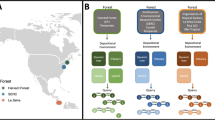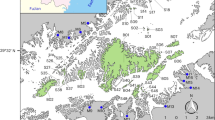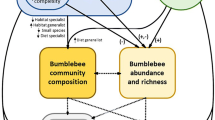Abstract
There is now a solid body of theoretical work1–4 demonstrating that the spatial structure of the habitat combined with animal movement strongly influence host–parasitoid dynamics. The spatial pattern over which parasitoid search takes place can be affected by the distribution of the hosts5, by the spatial arrangement of the host's habitat6 and by the spatial scale at which the parasitoid perceives variation in host abundance7,8. Empirical work, however, has been largely restricted to small-scale field studies of less than one hectare6,9 with very few larger10,11. Here we report initial results of a many-year, large-scale study that is among the first to examine the interaction between a population-level process (parasitism) and anthropogenic forest fragmentation at large and at multiple spatial scales. We demonstrate that parasitism by four species of parasitoids attacking the forest tent caterpillar, Malacosoma disstria, is significantly reduced or enhanced depending on the proportion of forested to unforested land. Each of the parasitoid species responds to this mosaic at four different spatial scales that correspond to their relative body sizes. Our data give empirical support to the argument that changes in landscape structure can alter the normal functioning of ecological processes such as parasitism, with large-scale population consequences3,4.
This is a preview of subscription content, access via your institution
Access options
Subscribe to this journal
Receive 51 print issues and online access
$199.00 per year
only $3.90 per issue
Buy this article
- Purchase on Springer Link
- Instant access to full article PDF
Prices may be subject to local taxes which are calculated during checkout
Similar content being viewed by others
References
Hassell, M. P. & May, R. M. Spatial heterogeneity and the dynamics of parasitoid-host systems. Ann. Zool. Fennici 25, 55–61 (1988).
Kareiva, P. Population dynamics in spatially complex environments: theory and data. Phil. Trans. R. Soc. B 330, 175–190 (1990).
May, R. M. in Large-scale Ecology and Conservation Biology (eds Edwards, P. J., May, R. M. & Webb, N. R.) 1–17 (Blackwell Scientific, Oxford, 1994).
Kareiva, P. & Wennergren, U. Connecting landscape pattern to ecosystem and population processes. Nature 373, 299–302 (1995).
Waage, J. K. Aggregation in field parasitoid populations: foraging time allocation by a population of Diadegma (Hymenoptera, Ichneumonidae). Ecol. Entomol. 8, 447–453 (1983).
Kruess, A. & Tscharntke, T. Habitat fragmentation, species loss, and biological control. Science 264, 1581–1584 (1994).
Heads, P. A. & Lawton, J. H. Studies on the natural enemy complex of the holly leaf-miner: the effects of scale on the detection of aggregative responses and the implications for biological control. Oikos 40, 267–276 (1983).
Rothman, L. D. & Darling, D. C. Spatial density dependence: effects of scale, host spatial pattern and parasitoid reproductive strategy. Oikos 62, 221–230 (1991).
Kareiva, P. Habitat fragmentation and the stability of predator-prey interactions. Nature 326, 388–390 (1987).
Rogers, D. J. & Williams, B. G. in Large-scale Ecology and Conservation Biology (eds Edwards, P. J., May, R. M. & Webb, N. R.) 247–271 (Blackwell Scientific, Oxford, 1994).
Marino, P. C. & Landis, D. A. Effects of landscape structure on parasitoid diversity and parasitism in agroecosystems. Ecol. Appl. 6, 276–284 (1996).
Sippell, W. L. Outbreaks of the forest tent caterpillar, Malacosoma disstria Hbn., a periodic defoliator of broad-leaved trees in Ontario. Can. Entomol. 94, 408–416 (1962).
Witter, J. A. & Kulman, H. M. The parasite complex of the forest tent caterpillar in northern Minnesota. Env. Entomol. 8, 723–731 (1979).
Parry, D. Larval and pupal parasitism of the forest-tent caterpillar Malacosoma disstria Hübner (Lepidoptera, Lasiocampidae) in Alberta, Canada. Can. Entomol 127, 877–893 (1995).
Godfray, H. C. J. Parasitoids: Behavioral and Evolutionary Ecology (Princeton Univ. Press, Princeton, 1994).
Roland, J. Large-scale forest fragmentation increases the duration of forest tent caterpillar outbreak. Oecologia 93, 25–30 (1993).
Roland, J. & Taylor, P. D. in Population Dynamics: New Approaches and Synthesis (eds Cappuccino, N. & Price, P. W.) 195–208 (Academic, San Diego, 1995).
Weseloh, R. M. Spatial distribution of gypsy moth (Lepidoptera: Lymantriidae) and some of its parisitoids within a forest environment. Entomophaga 17, 339–351 (1972).
Holling, C. S. Cross-scale morphology, geometry and dynamics of ecosystems. Ecol. Monogr. 62, 447–502 (1992).
McCullagh, P. & Nelder, G. A. Generalized Linear Models (Chapman & Hall, London, 1989).
Wilkinson, L., Hill, M., Miceli, S., Birkenbeuel, G. & Vang, E. SYSTAT for Windows: V.5 (Evanston, Illinois, 1992).
Author information
Authors and Affiliations
Rights and permissions
About this article
Cite this article
Roland, J., Taylor, P. Insect parasitoid species respond to forest structure at different spatial scales. Nature 386, 710–713 (1997). https://doi.org/10.1038/386710a0
Received:
Accepted:
Issue Date:
DOI: https://doi.org/10.1038/386710a0
This article is cited by
-
Habitat loss reduces abundance and body size of forest-dwelling dung beetles in an Amazonian urban landscape
Urban Ecosystems (2024)
-
Climate-induced forest dieback drives compositional changes in insect communities that are more pronounced for rare species
Communications Biology (2022)
-
The Vision of Managing for Pest-Resistant Landscapes: Realistic or Utopic?
Current Forestry Reports (2021)
-
A framework for predicting competition between native and exotic hymenopteran parasitoids of lepidopteran larvae using taxonomic collections and species level traits
BioControl (2021)
-
Mammal responses to spatial pattern in fire history depend on landscape context
Landscape Ecology (2021)
Comments
By submitting a comment you agree to abide by our Terms and Community Guidelines. If you find something abusive or that does not comply with our terms or guidelines please flag it as inappropriate.



